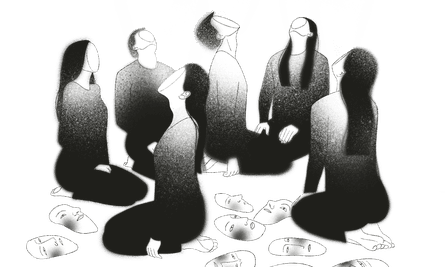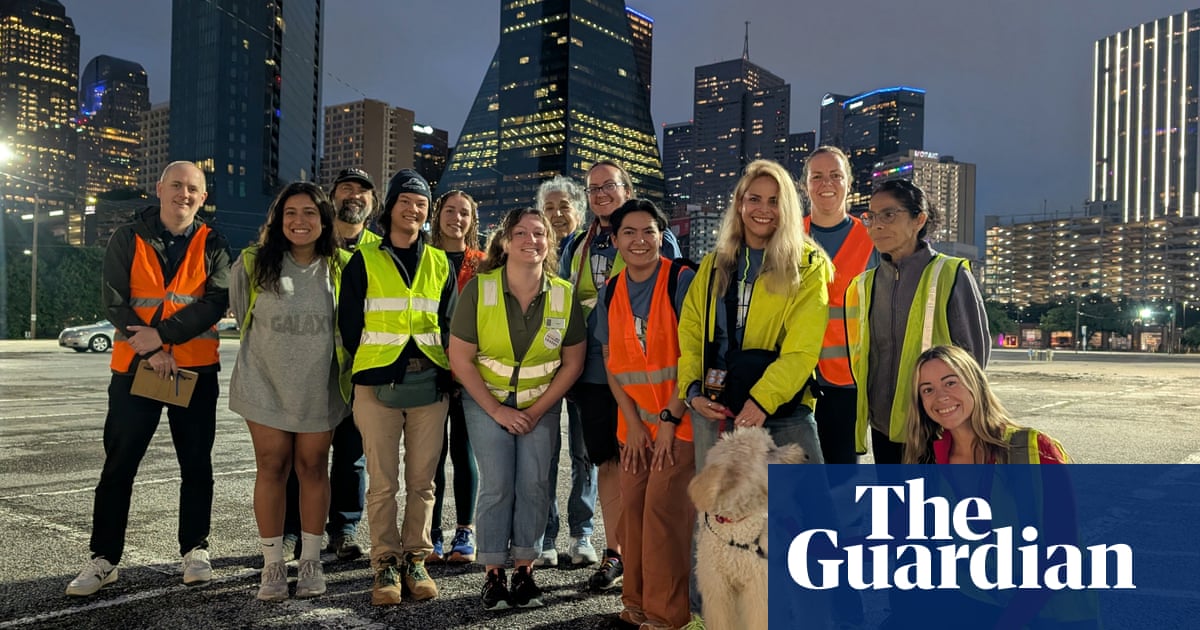
On a Saturday in March in a conference room with ugly carpeting near Los Angeles international airport, I meekly muttered “thank you” as a group of six people – all strangers until the day before – enumerated my deepest flaws.
“I see you, Katherine, as inauthentic,” led the charge.
“I see you, Katherine, as a self-fulfilling prophecy of disappointment.”
“I see you, Katherine, as closed off to intimacy.”
Each person stood before me, stared into my eyes, and rattled off my defects: I was cynical, guarded, deaf to my inner needs.
I was there to take part in a mindset-reset bootcamp offered by Mastery in Transformational Training, a Los Angeles county-based company better known as MITT. Around the room, roughly 120 other people huddled in their own small groups, variously weeping, giggling and shuffling in discomfort.
They came in every shade, from Burning Man devotee to buttoned CPA. They were barbers and brokers, kids with neck tattoos, tradwives and titans in the making. What they held in common was that everyone had declared they were “all in” to realizing the life of their dreams.
As a recent New York City to Los Angeles transplant, I had observed the glinting cheerfulness of my new Angeleno friends with an almost anthropological remove. In the weeks after fires torched the hills of Los Angeles and political conflagrations began to threaten democracy, the conversations I had with folks around town centered on horror, yes, but also – and to my consistent bafflement – on optimism.
My new neighbors repeatedly enjoined me to stay positive. “Well,” one earnest-eyed mother on the schoolyard told me, “we just have to believe that everything will work out.” Another insisted: “It’s up to you to be the light.”
I would hear this refrain often. If California is the epicenter of the revolution from within, Los Angeles is its most fevered expression. To stroll around the west side, where I live, is to take in a world of relentless self-tinkering, of inner truths pursued through cold plunges and adaptogenic smoothies. There are crystals everywhere, and palmists at the ready 24/7.
Everyone I talk to is in therapy or becoming a therapist themselves, practicing alongside an ever-widening pool of spiritual gurus, psychedelic guides, past-life whisperers and wellness visionaries, many of whom recirculate that central message: be the light.
My default mood is wary but intrigued – I’m a New Yorker after all – and I was curious to see if MITT’s intensive programs could help me tap into the well of positivity.
I was grabbing a post-pilates coffee with a Venice artist and chatting about feeling like a local misfit when my ears perked up. “You should try a masterclass in psychic recalibration,” she said. She couldn’t explain what it entailed, but said that if I could “trust the process”, I would step into a world of benefit.
I noticed that she referred to her life as if it were composed of distinct epochs. Before the training, she said, “it was like I had been in a coma.” Now, she said, she experienced more joy and realized, “I am in the driver’s seat.”
Those new to MITT begin with “basic” training, a three-day immersion that costs about $700 and promises “discovery in the most crucial aspects of your life”. The next step is the “advanced” course, which runs about $1,400, and, for the bold, a four-month “legacy” program.
Before I even set foot in the conference room, I was encouraged to sign up for further training. In my required pre-interview call, a staff member, Marilyn, assured me that advanced would bring me “answers to everything” and that she was “so excited” about my potential growth she was going to strike the outstanding $300 balance from my account so that I could invest it in my future.
The greater part of our call was devoted to going over sensitive mental health questions covering addiction, suicidality, depression, ADHD and prescription medications. Marilyn stressed that no one on the staff was a trained mental health professional or equipped to provide treatment to distressed persons.
Nonetheless, the course was likely at times to arouse discomfort, even touch on past traumas. It was, by design, intended to be “extremely triggering”.
In the conference room, Chris Lee, master trainer, spoke in expletive-studded listicles.
“Who wants their fucking life back? Who wants to experience rebirth? Who wants to get back the passion, the power, the sexy, the light? Who wants to clear away the fucking shit that’s getting in the way of getting shit done?”
(Part of trusting the process meant refraining from note taking; it was forbidden. I translated my observations as voice memos after the sessions were over.)
It was day two of a three-day program that ran from morning until deep into the night, structured around immersive exercises, lectures and possibly deliberate caloric deprivation: we did not break for lunch until 4pm and then went on until 11pm without pausing for dinner. But shame on anyone who dared to protest. Discomfort is a choice, Lee told us. Feeling tired is a choice.
“Katherine”, my group continued to chronicle my shortcomings, “I see you as judgmental.”
I’d like to believe that under normal circumstances, comments lobbed by strangers would not faze me unduly. But these little bombs detonated deep within.
In the preceding exercise, Lee had instructed us to share our deepest traumas, and only minutes prior I had been gasping for dear life as I described pains I’ve guarded even from my dearest friends. Tearing up as I mumbled my thanks, I felt capsized by vulnerability.
Perhaps it was the relative anonymity of the room that led me to divulge my demons with so little prodding. But if I’m being honest, it was the cumulative pressure to share that forced me to open up. The point of this soul-baring was to identify how our foundational wounds had mottled the stories we tell ourselves and, consequently, derailed us from the better, more prosperous life we could be living.

“Self-worth is net worth,” Lee had lectured. No matter how harrowing your past, to be a victim is a choice. Every trigger is a teacher. Every breakdown is a blessing.
I thought to myself: “Uh-oh. This weekend was not headed in the direction I’d planned.”
Stress, it turns out, is the point. The program is designed to ferry participants through a prescribed emotional course, from agitation to catharsis and ultimately to feelings of love and identification with the group.
However, this emotional flooding, induced over a compressed period of time, may be hazardous for some. The potential problems arising were the undoing of MITT’s precursor, Lifespring, a for-profit personal development company that ceased operations in the mid-1990s following a series of lawsuits from participants alleging psychological distress and physical harm.
Lifespring was one of several companies to emerge from the fertile soils of the mid-20th century’s human potential movement that aimed to help individuals experience a “breakthrough”. An underpinning theory, which has not been borne out by science, was that the majority of people use only 10% of their brains. The right training, it was theorized, could unlock stores of talent and alchemize middle-class malaise into greatness.
“Certain aspects of human beings can’t change,” John Hanley, one of the founders of Lifespring wrote in 1989. “Therein lies the power of transformation: the possibility of looking at yourself and the world in a new way can liberate you from a fixed, rigid sense of reality – even the aspects of reality that are, in fact, unchangeable.”
In the early 1970s, Hanley, then a recent college graduate, attended a breakthrough seminar, which offered military-style trainings that relied on a number of abusive practices to effect transformation – including beatings, sexual humiliation, food deprivation and stringing attendees up on crosses. When Hanley, as part of his training, was stuffed inside a coffin for 14 hours, he responded by falling asleep. His trainers were so impressed that they invited him to join their staff.
Hanley soon started to elaborate his own “technologies” for self-discovery and in 1974 launched Lifespring, which was based on three successive levels of training to bolster personal effectiveness. The company was enormously successful. Over two decades, offices across the country enrolled roughly 400,000 participants. Lifespring relied on enrollees to get their friends and colleagues to sign up; sometimes entire families participated. Proponents spoke of gains across their careers and personal lives, and of finding liberation from self-defeating patterns.
However, by the 1980s, a number of court battles painted a different picture – one marred by manipulation, abuse and even death. In 1987, journalist Marc Fisher wrote an exposé of the company for the Washington Post magazine, in which he noted: “At least five lawyers around the country specialize in suing Lifespring on behalf of trainees who have had psychotic episodes or other emotional strains they attribute to the training.”
At the time of the article’s publication, six trainees had died and there were about 35 lawsuits. Among the more sensational cases was that of a 27-year-old woman from Seattle who suffered an asthma attack during basic training in 1979, fell into a coma and eventually died. The trainers, who held on to her medications, had told her that her problem was “self-caused”. Lifespring denied responsibility and in 1980 settled with the family for $450,000.
In the matter of the death of Artie Barnett, a man who could not swim but had been persuaded to jump into the Willamette river to overcome his fears, Lifespring denied any responsibility. Fisher quotes Hanley as saying at the time: “The training doesn’t cause anything. Life causes stuff.”
After Lifespring was shuttered in the mid-1990s, a former trainee and owner of a Beverly Hills spa named Margo Majdi bought the rights to the trainings and relaunched the enterprise as MITT.
Roger Morgan, the co-founder and CEO of MITT, told me that while “times have changed” and the training is “less militant”, it is essentially the same. “We empower people to be abundant,” he said.
Then, as now, a banner hanging above the stage asks: “What are you pretending not to know?”
Saturday afternoon found me sitting in my chair with my eyes closed, flailing my arms above my head and screaming at my father. A terrifying noise issued from my mouth and joined the other chilling sounds that filled the room and doubtlessly frightened the other guests of the hotel.
Lee was leading us in a guided meditation to help us reconnect with our innate potential. Earlier he had drawn a crude picture of a smiling baby’s face on a sheet of easel pad. This, he said, was how we entered the world, happy and trusting. But then came sadness and disappointment.
As he said this, Lee slashed at the face with his marker. Mean words from mom or dad. Slash, slash. The teacher who didn’t believe in you, the sweetheart who betrayed you. Culture. Religion. The word “no”. Soon the baby’s face was all but obscured.
Dead, Lee pronounced.
But now, we were on a journey of resurrection. Lee had led us up a mountain, down a corridor, in and out of closed doors, and we had come at last to a room filled with coffins and there, inside of one, lay our inner child, whom we were called upon to reanimate.
When Lee had presented the idea of rebirth, he had flipped to a clean page on the easel pad. This big white blank represented “limitless potential”. Maybe it’s just the writer in me, but I found the symbol disconcerting: a void of history, social ties and shared meaning. To me, that seemed like the basis of a nervous breakdown, but here it signaled a fresh start. “Breakthrough occurs through inventing your identity from nothing,” Hanley had wrote, “not through improving your already entrenched image”.
Our inner children regained, we were prepared to move towards the pinnacle of the training: manifestation. The concept of resurrection is, of course, rich with Christian meaning, but it was the subsequent sessions that bled religiosity. Lee stood on top of a chair with his arms outspread, calling on the room to call in the good life. We should let go and let God, he said. The universe would provide. We all deserve an upgrade, he boomed into the mic while the room snapped their fingers. We are all worthy of first class.

One phrase that got a lot of airtime was the Rumi-attributed quote: “Live life as if everything is rigged in your favor.” This strand, embraced by “law of attraction” enthusiasts, has been refashioned as the declarative: “The universe is rigged in your favor,” and it was repeated with sufficient frequency that by the end of the weekend it was being uttered as a sort of call and response. Lee: “the universe is …” Cheering participants: “ … rigged in your favor”!
What follows is the faith that you, yes you, can realize whatever love, wealth and opportunity you can dream up. It all boils down to mindset.
It is, on the one hand, a potentially powerful exercise to claim that you deserve more than you have – the raise, the romance, the admiration of peers. But it contains a downright dangerous edge. It’s not just the magical thinking (the unemployed 19-year-old telling the room that he’s going to “make a mil” by the end of the year), it is the insistence that if you’re not crushing your goals, if the heavens are not raining dollar bills, it is the result of your own lack of faith.
You don’t want it strongly enough. You’re still bogged down by doubts, fears and cowardice. In other words, you need further training.
On Sunday, the mood in the room was elation. Smiles were wide, guards were down. Strangers no more, it was a room filled with friends and everyone was primed to hear about what was coming next.
“The most important five days of your life”, was how advanced training was presented in the course of a two-hour pitch. Everyone was encouraged to sign up then and there – the next round was beginning the following week – and those who did were given the mic to belt out their commitment.
Those who declined or deferred were met with an interrogation. “Why are you standing in your way?” Lee asked the defectors. Even if you don’t have the time off from work, or the childcare, or the money. What was a little debt when you were investing in the rest of your life?
When I first spoke with Morgan, the MITT CEO, he asked that I refrain from writing this piece until I took the advanced course. “You will write a different story after the advanced training,” he told me. “You will be a different person.” By foregoing the experience I was foreclosing on joy. “Trust the old man,” he said, “Run, don’t walk, to advanced.”
The hardest push, to my surprise, came from the leader of my small group, a 27-year-old who impressed me with his unflappable calm and aura of integrity. Now he badgered us to sign on. I realized only after the fact that this was a feature of his role. Those participating in the legacy program and beyond are required to recruit new participants. When they graduate, they are encouraged to staff the trainings.
Morgan described this to me as the gift of service. Staffing, he said, was really the second half of the training.
When I mentioned this to Devin, a 41-year-old I had connected with over social media, who went all the way through the program in 2018, he scoffed. While he had derived a lot of value from the sessions, he disliked the compulsory recruitment and the pressure to work for the company. He had agreed to staff numerous trainings, until that became too time-consuming, “irritating” and “exploitive”. The last time Morgan asked him to staff, Devin said: “I told him to fuck off.”
The resentment is understandable given that all staffers are volunteers, putting in marathon hours for days at a time, with nary so much as a comped lunch. In the room, we were encouraged to applaud the selfless service of the two dozen-odd men and women helping Lee, the master trainer, manage the group. But this is not a scrappy all-hands-on-deck organization. This is a for-profit entity.
Assuming all participants in my basic program paid the standard enrollment fee, the weekend brought in more than $80,000.
In the days after the training, I continued to communicate with my small group and other participants from the course. The collective high was initially palpable. Everyone was going to achieve it all. But as the days passed, the general mood drifted back down to earth, and gradually these channels fell silent.
Keen to understand what I had just gone through, I reached out to John Hunter, a research psychologist at Varsity College in South Africa, who studies what’s known as large group awareness trainings (LGATs), such as MITT.
Hunter maintains that even though there are “hundreds” of LGATs around the world, “most can be traced back to Lifespring” and its contemporaries. They hinge, he says, on significant stress followed by a social reward, and it is this process that generates the “transient experience of transformation”.
While most studies of LGATs suggest there are no long-term benefits derived from such trainings, I spoke with several graduates of MITT who felt they had reaped lasting rewards. Many of the benefits they described were intangibles, like confidence and positivity. But they also shared achievements that they linked directly to the training: getting a promotion, leaving an unsatisfying marriage, reconnecting with an estranged sibling.
Kamal, a 42-year-old from Orange county, said MITT gave him “the confidence to venture into the unknown”. He said that the training exercises served as mirrors. “Any reservations you’re experiencing [in the training] have to do with how you’re approaching life. The challenge is to push past the discomfort. You relearn to respond to life rather than react to it.”
I also spoke with those who took issue with the courses. The criticism I heard most often was that any fault found in the program was recast as an individual problem. It was not, for instance, that the trainer was picking on you, it was that you were disengaged and undermining your own development. It was not that the content bordered on woo-woo, it was that you were too jaded to revel in the miracle on offer.
Jose (who requested a pseudonym for privacy) recalled an exercise from his advanced training in which he had to circulate through the room while different groups of people shouted insults at him. “They were calling me lazy and arrogant and unmotivated,” he said. “Afterwards I think my guard was up a bit, I was defensive, and my group became relentless in breaking me down. Anything I did, I couldn’t be vulnerable enough.”
While Lifespring was swamped by lawsuits, few legal complaints have been lodged against MITT. This might have to do with the fact that the company requires participants to sign a “hold harmless agreement”, in which they agree not to sue MITT and to settle any disputes that arise out of court.
Though the majority of participants appear to emerge unscathed, if not necessarily enlightened, some experts believe that these transformational programs pose real hazards to the psyche. An early assessment of a Lifespring basic by a clinical psychologist and a sociologist concluded that the training was “essentially pathological”.
Another psychological study of LGAT structures, ominously titled Iron fists/velvet gloves, concluded that the dynamic amounted to an “attack on the self” and that the resulting “identity impasse” was resolved only by converting to the organisation.
Hunter, the LGAT researcher, has a diagnosis of bipolar disorder. Following his own participation in an LGAT, he recognized that it elicited features similar to a hypomanic episode. For some, this looks like elevated mood and ebullient feelings of love and universality. Under adverse conditions, however, these swells can become grandiosity, impulsivity and psychosis.
“You can’t just count the hits and ignore the misses,” he said. For the person successfully negotiating a raise or getting a date with someone they admire, “that’s a wonderful story”, he said. “But you’ve also got to acknowledge that the nature of people taking risks is that some are not going to pay off.”
Vee went through the trainings a decade ago. At the end of the basic course she said she “noticed the hard sell”, but said, “you’re in a dopamine rush by that last day, and everyone is telling you to commit with your group, to not let your group down. They really push you. It’s like a timeshare sell.”
She credits MITT with helping her re-evaluate certain behaviors and strengthen her primary relationship. However, after several years of therapy she now believes the program was “extremely dangerous” and often left people “raw and open and vulnerable” without proper support. “I’m so upset thinking about it even now,” she told me. “All the people I know who ended up in a worse place. The broken relationships, broken marriages.”
In the end, she believes the main motive is profit. There were no true believers at the top. “They break you down, then bring you back up, so you can give them money.”
Indeed, when my basic cohort was talking about what they wished to manifest, several people said that what they wanted above all was to be the coach in that very same room. Throughout the weekend, coaches were presented as though deities; Tony Robbins was invoked in the same breath as Martin Luther King Jr.
Ostensibly, the role of the coach is to empower people. But as my weekend peers proclaimed their dreams, I stumbled over the underlying irony. To be convinced that you should reach for your untapped greatness, you have to first be convinced of your existing lack.
When I asked Hunter whether it was all about money, he said that profit was part of it, but so was power. “I think if you want to be seen as a god, then there’s no better way than to be a leader in one of these organizations.”

 6 hours ago
9
6 hours ago
9

















































